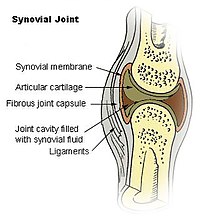Image via Wikipedia
What is cartilage?
Cartilage is a tough, fibrous material found in joints throughout the body. Its primary purpose is to act as a buffer to stop bones rubbing together.
In the knee it takes the form of a C-shaped piece of material called the meniscus.
1. Muscles
2. Tendon
3. Patella
4. Cartilage
5. Cruciate ligament
6. Medial ligament
7. Medial meniscus
8. Tibia
9. Fibula
10. Lateral ligament
11. Lateral meniscus
12. Femur
What can go wrong?
The majority of the meniscus has no blood supply.
For that reason, when damaged, the meniscus is unable to undergo the normal healing process that occurs in most of the rest of the body.
In addition, with age, the meniscus begins to deteriorate, often developing degenerative tears.
A partial or total tear of a meniscus may occur when a person quickly twists or rotates the upper leg while the foot stays still.
Typically, when the meniscus is damaged, the torn piece begins to move in an abnormal fashion inside the joint.
Because the space between the bones of the joint is very small, the torn fragment may become caught between the bones of the joint.
When this happens, the knee becomes painful, swollen, and difficult to move.
How is it treated?
If the tear is minor and the pain and other symptoms go away, the doctor may recommend a muscle-strengthening programme.
If the tear to a meniscus is more extensive, the doctor may perform keyhole surgery to see the extent of injury and to repair the tear.
The doctor can sew the meniscus back in place if the patient is relatively young, the injury is in an area with a good blood supply, and the ligaments are intact.
If the patient is elderly or the tear is in an area with a poor blood supply, the doctor may cut off a small portion of the meniscus to even the surface.
In some cases the doctor removes the entire meniscus.
Is removal a good idea?
Removal can increase the risk of degenerative problems in the knee such as the development of osteoarthritis.
However, if a torn meniscus goes untreated, flapping around within the joint, this too may result in osteoarthritis.
Is recovery quick?
On average, most patients are able to walk without crutches within 48 hours.
Sources: BBC NEWS12 Dec.2003
Related articles
- My knee hyperflexed the other day, now ts tight, sore and makes a clcking sound what could be wrong? (zocdoc.com)
- Why do my knees feel like they cannot straighten fully? (zocdoc.com)
- Can I get my torn cartilage repaired? (zocdoc.com)
- When I bend my left knee, there is a certain points where I hear a *click*. Do I have arthritis? (zocdoc.com)
- Meniscus-healing stem cell bandage approved for clinical trials (gizmag.com)
- Knees Pain (findmeacure.com)
- Common Knee Injuries (drandrewrokitoorthopedist.wordpress.com)

